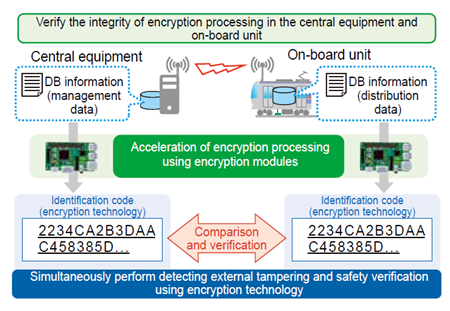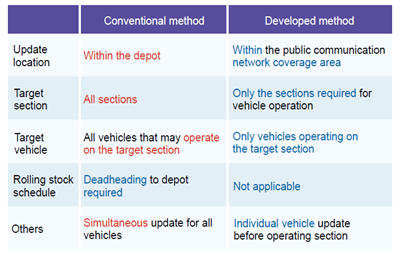17. Method for Updating On-board Databases Using Public Communication Networks
In on-board train protection systems with databases containing railway track conditions and related information, the database must be updated whenever conditions such as track alignment change. Currently, staff are required to perform update operations for each vehicle within the depot, which limits the update location to the depot and involves significant labor and time—these have been ongoing challenges.
Therefore, we proposed a method that utilizes public communication networks to deliver data to on-board unit and automatically update the databases. To implement such a method, technology is required to verify within a short time of about a few minutes that there are no cyberattacks from external sources and no errors in the delivered data. This method not only provides security features such as detecting external tampering of delivered data but also enables simultaneous verification of errors in the delivered data caused by encryption module faults or communication errors.
Specifically, along with the data delivered from the central equipment to the on-board unit, an encrypted identification code of the data is transmitted to the on-board unit via public communication networks. The on-board unit encrypts the received data to generate an identification code, which it then compares and verifies against the transmitted identification code. If there is a mismatch, the data is retransmitted. However, since generating the identification code on the on-board unit requires time, a high-speed encryption module is applied to shorten the processing time (Figure 1). Additionally, a test unit for this method was constructed to verify functions such as the detection of mismatches and the required verification time relative to data volume.
This method allows on-board databases to be updated within a few minutes at any location within the coverage area of public communication networks, making it possible to perform updates even while the train is stopped at a station (Table 1). Furthermore, by not registering the entire on-board database in advance and instead receiving and updating only the necessary data ahead of each section according to the running section, it becomes easier to introduce on-board database-based train protection systems on through service lines where various vehicles operate.
Other Contents
- 9. Design Method for Post-installed Anchor Joint Members in the Reconstruction of Concrete Structures
- 10. Reinforcement Method for Preventing Fatigue Cracks at Steel Girder Support Sections
- 11. Method for Identifying Potentially Critical Locations of Loose Bearing Based on On-board-measured Track Geometry
- 12. Extension of Rail Replacement Cycles Considering Fatigue/Soundness
- 13. Support Method for Extending Inspection Periods Based on Statistical Analysis of Equipment Inspection Records
- 14. Automated Visual Inspection System for Vehicle Underbody
- 15. Autonomous Train Operation System
- 16. General Purpose Real-time Algorithm for Generating Driving Curves for Driver Advisory System
- 17. Method for Updating On-board Databases Using Public Communication Networks
- 18. Labor-saving for Generating Crew Schedule to Enable Workforce Efficiency and Reduce Labor Burden
- 9. Design Method for Post-installed Anchor Joint Members in the Reconstruction of Concrete Structures
- 10. Reinforcement Method for Preventing Fatigue Cracks at Steel Girder Support Sections
- 11. Method for Identifying Potentially Critical Locations of Loose Bearing Based on On-board-measured Track Geometry
- 12. Extension of Rail Replacement Cycles Considering Fatigue/Soundness
- 13. Support Method for Extending Inspection Periods Based on Statistical Analysis of Equipment Inspection Records
- 14. Automated Visual Inspection System for Vehicle Underbody
- 15. Autonomous Train Operation System
- 16. General Purpose Real-time Algorithm for Generating Driving Curves for Driver Advisory System
- 17. Method for Updating On-board Databases Using Public Communication Networks
- 18. Labor-saving for Generating Crew Schedule to Enable Workforce Efficiency and Reduce Labor Burden


